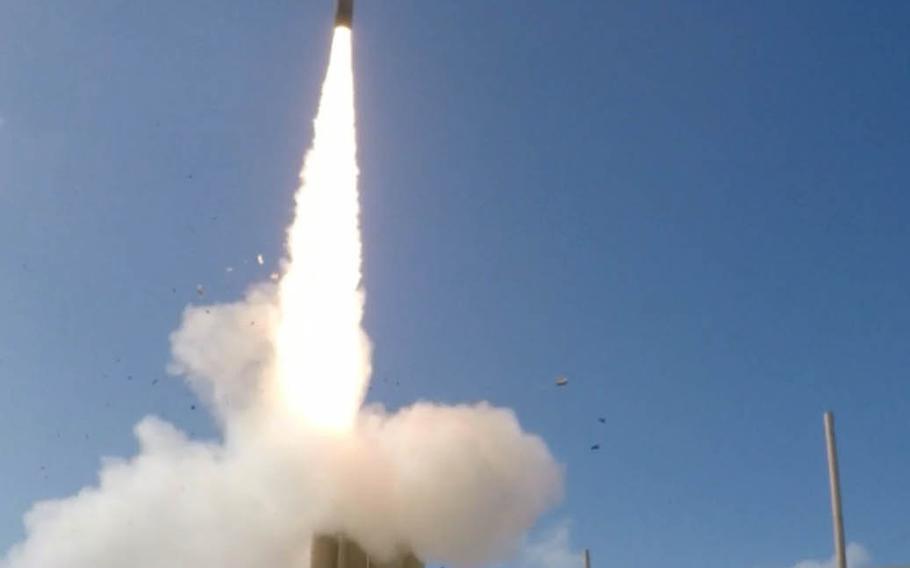
A Terminal High Altitude Area Defense, or THAAD, interceptor is launched from Wake Island in the western Pacific Ocean, Nov. 1, 2015. During the test, the THAAD system successfully intercepted two air-launched ballistic missile targets. (Missile Defense Agency)
Placement of a U.S. mobile missile defense system in South Korea remains unlikely in the near term despite continued concern about North Korea’s nuclear program, analysts and government officials say.
Top U.S. military officials want the Terminal High Altitude Area Defense system, or THAAD, ready to deploy in the Asia-Pacific region on a permanent basis — and its bases in South Korea are ideally where they need to be to counter a possible North Korean offensive.
Last year, Deputy Secretary of Defense Robert Work said the Pentagon had conducted site surveys for THAAD within South Korea. However, what makes sense from a military tactical standpoint doesn’t always correspond with how leaders view the strategic and diplomatic consequences.
When rumors spread in March of a deal to deploy THAAD to South Korea in an emergency, China decried the possibility as a threat to its security, with Russia voicing opposition as well.
That left South Korea uncomfortably positioned in a dispute pitting China and Russia on one side and the United States and Japan on the other, said Kim Hyun-wook, a professor at the Korea National Diplomatic Academy in Seoul.
The result was that despite discussions between President Barack Obama and South Korean President Park Geun-hye earlier this year, along with high-level ministerial talks between both nations, neither side has confirmed ever having had formal talks about THAAD.
Seoul’s caution in regard to THAAD also comes from concern over harming its recently stabilized relations with Pyongyang, Kim said.
The Koreas have technically remained at war since 1953, so everything is relative when it comes to measuring stability. But recent cross-border family reunions and a series of official talks that began in November — the most recent took place Friday at a North Korean border town, according to The Associated Press — aren’t something the South wants to jeopardize, Kim said.
“The situation is now considerably better than it was last spring,” Kim said. “It would be making a fool of ourselves to [deploy THAAD].”
If North Korea carries out another nuclear test, as it occasionally threatens to do through its propaganda channels, that could always cause South Korea to re-evaluate its needs for THAAD, Kim added.
Although China objects to THAAD, relations with Beijing probably wouldn’t be affected all that much, Kim said.
Kim and other analysts have speculated that China is more interested in loosening the U.S.-South Korea alliance than it is actually worried about THAAD.
THAAD can detect threats up to about 620 miles away, but its operational range is roughly 125 miles, according to Missile Threat, a project of the George C. Marshall and Claremont institutes.
Moreover, THAAD is designed to intercept missiles inside or just outside the atmosphere in their final phase. If THAAD intercepted a Chinese missile, it would be in the unlikely event that China launched one against South Korea, according to a paper published in April by Pacific Forum Center for Strategic and International Studies, a Honolulu-based think tank.
In the meantime, the Pentagon is keeping THAAD stashed away in Guam, about 2,000 miles from Seoul. Its presence in Guam is rotational, but Army Pacific Commander Gen. Vincent Brooks told reporters Tuesday that it’s time to station THAAD there permanently, according to Military.com.
Keeping THAAD in Guam “will make it possible for us to have more options for commitment of THAAD in other places if asked,” Brooks added.
Stars and Stripes staffer Yoo Kyong Chang contributed to this report.
Twitter: @eslavin_stripes